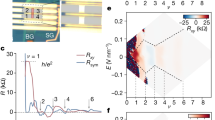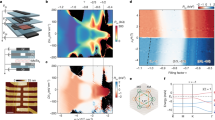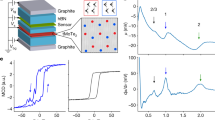Abstract
The interplay between spontaneous symmetry breaking and topology can result in exotic quantum states of matter. A celebrated example is the quantum anomalous Hall (QAH) state, which exhibits an integer quantum Hall effect at zero magnetic field owing to intrinsic ferromagnetism1,2,3. In the presence of strong electron–electron interactions, fractional QAH (FQAH) states at zero magnetic field can emerge4,5,6,7,8. These states could host fractional excitations, including non-Abelian anyons—crucial building blocks for topological quantum computation9. Here we report experimental signatures of FQAH states in a twisted molybdenum ditelluride (MoTe2) bilayer. Magnetic circular dichroism measurements reveal robust ferromagnetic states at fractionally hole-filled moiré minibands. Using trion photoluminescence as a sensor10, we obtain a Landau fan diagram showing linear shifts in carrier densities corresponding to filling factor v = −2/3 and v = −3/5 ferromagnetic states with applied magnetic field. These shifts match the Streda formula dispersion of FQAH states with fractionally quantized Hall conductance of \({\sigma }_{xy}=-\,\frac{2}{3}\frac{{e}^{2}}{h}\) and \({\sigma }_{xy}=-\,\frac{3}{5}\frac{{e}^{2}}{h}\), respectively. Moreover, the v = −1 state exhibits a dispersion corresponding to Chern number −1, consistent with the predicted QAH state11,12,13,14. In comparison, several non-ferromagnetic states on the electron-doping side do not disperse, that is, they are trivial correlated insulators. The observed topological states can be electrically driven into topologically trivial states. Our findings provide evidence of the long-sought FQAH states, demonstrating MoTe2 moiré superlattices as a platform for exploring fractional excitations.
This is a preview of subscription content, access via your institution
Access options
Access Nature and 54 other Nature Portfolio journals
Get Nature+, our best-value online-access subscription
$29.99 / 30 days
cancel any time
Subscribe to this journal
Receive 51 print issues and online access
$199.00 per year
only $3.90 per issue
Buy this article
- Purchase on Springer Link
- Instant access to full article PDF
Prices may be subject to local taxes which are calculated during checkout




Similar content being viewed by others
Data availability
Source data are provided with this paper.
References
Haldane, F. D. M. Model for a quantum Hall effect without Landau levels: condensed-matter realization of the “parity anomaly”. Phys. Rev. Lett. 61, 2015 (1988).
Chang, C.-Z., Liu, C.-X. & MacDonald, A. H. Colloquium: Quantum anomalous Hall effect. Rev. Mod. Phys. 95, 011002 (2023).
Chang, C.-Z. et al. Experimental observation of the quantum anomalous Hall effect in a magnetic topological insulator. Science 340, 167–170 (2013).
Regnault, N. & Bernevig, B. A. Fractional Chern insulator. Phys. Rev. 1, 021014 (2011).
Neupert, T., Santos, L., Chamon, C. & Mudry, C. Fractional quantum Hall states at zero magnetic field. Phys. Rev. Lett. 106, 236804 (2011).
Tang, E., Mei, J.-W. & Wen, X.-G. High-temperature fractional quantum Hall states. Phys. Rev. Lett. 106, 236802 (2011).
Sheng, D., Gu, Z.-C., Sun, K. & Sheng, L. Fractional quantum Hall effect in the absence of Landau levels. Nat. Commun. 2, 389 (2011).
Zhang, Y.-H., Mao, D., Cao, Y., Jarillo-Herrero, P. & Senthil, T. Nearly flat Chern bands in moiré superlattices. Phys. Rev. B 99, 075127 (2019).
Nayak, C., Simon, S. H., Stern, A., Freedman, M. & Sarma, S. D. Non-Abelian anyons and topological quantum computation. Rev. Mod. Phys. 80, 1083 (2008).
Hayakawa, J., Muraki, K. & Yusa, G. Real-space imaging of fractional quantum Hall liquids. Nat. Nanotechnol. 8, 31–35 (2013).
Wu, F., Lovorn, T., Tutuc, E., Martin, I. & MacDonald, A. Topological insulators in twisted transition metal dichalcogenide homobilayers. Phys. Rev. Lett. 122, 086402 (2019).
Li, H., Kumar, U., Sun, K. & Lin, S.-Z. Spontaneous fractional Chern insulators in transition metal dichalcogenide moiré superlattices. Phys. Rev. Res. 3, L032070 (2021).
Devakul, T., Crépel, V., Zhang, Y. & Fu, L. Magic in twisted transition metal dichalcogenide bilayers. Nat. Commun. 12, 6730 (2021).
Yu, H., Chen, M. & Yao, W. Giant magnetic field from moiré induced Berry phase in homobilayer semiconductors. Natl Sci. Rev. 7, 12–20 (2020).
Laughlin, R. B. Anomalous quantum Hall effect: an incompressible quantum fluid with fractionally charged excitations. Phys. Rev. Lett. 50, 1395 (1983).
Hasan, M. Z. & Kane, C. L. Colloquium: Topological insulators. Rev. Mod. Phys. 82, 3045 (2010).
Wen, X.-G. Colloquium: Zoo of quantum-topological phases of matter. Rev. Mod. Phys. 89, 041004 (2017).
Tsui, D. C., Stormer, H. L. & Gossard, A. C. Two-dimensional magnetotransport in the extreme quantum limit. Phys. Rev. Lett. 48, 1559 (1982).
Mai, P., Feldman, B. E. & Phillips, P. W. Topological Mott insulator at quarter filling in the interacting Haldane model. Phys. Rev. Res. 5, 013162 (2023).
Xiao, D., Zhu, W., Ran, Y., Nagaosa, N. & Okamoto, S. Interface engineering of quantum Hall effects in digital transition metal oxide heterostructures. Nat. Commun. 2, 596 (2011).
Deng, Y. et al. Quantum anomalous Hall effect in intrinsic magnetic topological insulator MnBi2Te4. Science 367, 895–900 (2020).
Sharpe, A. L. et al. Emergent ferromagnetism near three-quarters filling in twisted bilayer graphene. Science 365, 605–608 (2019).
Serlin, M. et al. Intrinsic quantized anomalous Hall effect in a moiré heterostructure. Science 367, 900–903 (2020).
Chen, G. et al. Tunable correlated Chern insulator and ferromagnetism in a moiré superlattice. Nature 579, 56–61 (2020).
Li, T. et al. Quantum anomalous Hall effect from intertwined moiré bands. Nature 600, 641–646 (2021).
Spanton, E. M. et al. Observation of fractional Chern insulators in a van der Waals heterostructure. Science 360, 62–66 (2018).
Xie, Y. et al. Fractional Chern insulators in magic-angle twisted bilayer graphene. Nature 600, 439–443 (2021).
Zhang, Y., Liu, T. & Fu, L. Electronic structures, charge transfer, and charge order in twisted transition metal dichalcogenide bilayers. Phys. Rev. B 103, 155142 (2021).
Crépel, V. & Fu, L. Anomalous Hall metal and fractional Chern insulator in twisted transition metal dichalcogenides. Phys. Rev. B 107, L201109 (2023).
Anderson, E. et al. Programming correlated magnetic states via gate controlled moiré geometry. Science 381, 325–330(2023).
Nuckolls, K. P. et al. Strongly correlated Chern insulators in magic-angle twisted bilayer graphene. Nature 588, 610–615 (2020).
Chernikov, A. et al. Exciton binding energy and nonhydrogenic Rydberg series in monolayer WS2. Phys. Rev. Lett. 113, 076802 (2014).
Xu, Y. et al. Correlated insulating states at fractional fillings of moiré superlattices. Nature 587, 214–218 (2020).
Regan, E. C. et al. Mott and generalized Wigner crystal states in WSe2/WS2 moiré superlattices. Nature 579, 359–363 (2020).
Popert, A. et al. Optical sensing of fractional quantum Hall effect in graphene. Nano Lett. 22, 7363–7369 (2022).
Vanhala, T. I. et al. Topological phase transitions in the repulsively interacting Haldane–Hubbard model. Phys. Rev. Lett. 116, 225305 (2016).
Jain, J. K. Composite-fermion approach for the fractional quantum Hall effect. Phys. Rev. Lett. 63, 199–202 (1989).
Wang, C. et al. Fractional Chern insulator in twisted bilayer MoTe2. Preprint at https://arxiv.org/abs/2304.11864 (2023).
Reddy, A. P., Alsallom, F. F., Zhang, Y., Devakul, T. & Fu, L. Fractional quantum anomalous Hall states in twisted bilayer MoTe2 and WSe2. Phys. Rev. B 108, 85117 (2023).
Parameswaran, S. A., Roy, R. & Sondhi, S. L. Fractional quantum Hall physics in topological flat bands. C. R. Phys. 14, 816–839 (2013).
Bergholtz, E. J. & Liu, Z. Topological flat band models and fractional Chern insulators. Int. J. Mod. Phys. B 27, 1330017 (2013).
Neupert, T., Chamon, C., Iadecola, T., Santos, L. H. & Mudry, C. Fractional (Chern and topological) insulators. Phys. Scr. 2015, 014005 (2015).
Liu, Z. & Bergholtz, E. J. in Reference Module in Materials Science and Materials Engineering https://doi.org/10.1016/B978-0-323-90800-9.00136-0 (Elsevier, 2023).
Wang, X. et al. Light-induced ferromagnetism in moiré superlattices. Nature 604, 468–473 (2022).
Wang, Y.-F., Gu, Z.-C., Gong, C.-D. & Sheng, D. N. Fractional quantum Hall effect of hard core bosons in topological flat bands. Phys. Rev. Lett. 107, 146803 (2011).
Ledwith, P. J., Tarnopolsky, G., Khalaf, E. & Vishwanath, A. Fractional Chern insulator states in twisted bilayer graphene: an analytical approach. Phys. Rev. Res. 2, 023237 (2020).
Abouelkomsan, A., Liu, Z. & Bergholtz, E. J. Particle–hole duality, emergent fermi liquids, and fractional Chern insulators in moiré flatbands. Phys. Rev. Lett. 124, 106803 (2020).
Wilhelm, P., Lang, T. C. & Läuchli, A. M. Interplay of fractional Chern insulator and charge density wave phases in twisted bilayer graphene. Phys. Rev. B 103, 125406 (2021).
Repellin, C. & Senthil, T. Chern bands of twisted bilayer graphene: fractional Chern insulators and spin phase transition. Phys. Rev. Res. 2, 023238 (2020).
Niu, Q., Thouless, D. J. & Wu, Y.-S. Quantized Hall conductance as a topological invariant. Phys. Rev. B 31, 3372–3377 (1985).
Acknowledgements
We thank X. Wang for discussions. C.W. acknowledges discussions with Y. He and H. Li. This project is mainly supported by the US Department of Energy (DOE), Office of Science, Basic Energy Sciences (BES), under the award DE-SC0018171. RMCD measurements are partially supported by Air Force Office of Scientific Research (AFOSR) Multidisciplinary University Research Initiative (MURI) programme, grant number FA9550-19-1-0390. Measurements of electrical control of topological phase transitions are partially supported by AFOSR FA9550-21-1-0177. The device fabrication is partially supported by the Center on Programmable Quantum Materials, an Energy Frontier Research Center funded by DOE BES under award DE-SC0019443. We acknowledge the use of the facilities and instrumentation supported by NSF MRSEC DMR-1719797. E.A. and W.H. acknowledge the support by the National Science Foundation Graduate Research Fellowship Program under grant number DGE-2140004. F.F. and W.Y. acknowledge support from the Research Grants Council of Hong Kong SAR (AoE/P-701/20, HKU SRFS2122-7S05) and Croucher Foundation. C.W. and D.X. acknowledge the support from DoE BES under the award DE-SC0012509. K.W. and T.T. acknowledge support from the JSPS KAKENHI (grant numbers 19H05790, 20H00354 and 21H05233). X.X. acknowledges support from the State of Washington funded Clean Energy Institute and from the Boeing Distinguished Professorship in Physics.
Author information
Authors and Affiliations
Contributions
X.X. conceived of and supervised the experiment. J.C. and E.A. fabricated the devices. T.T. and K.W. provided hBN crystals. E.A. and J.C. performed the magneto-optical measurements with help from W.H. and Y.Z. J.C., E.A. and X.X. analysed the data and interpreted the results, with theoretical input from F.F., L.F., T.C., D.X. and W.Y. L.F. contributed to the idea of trion sensing. C.W., X.Z., X.L., Y.R., T.C. and D.X. performed first-principles and exact diagonalization studies. J.C., E.A., L.F., D.X., W.Y. and X.X. wrote the paper with input from all authors. All authors discussed the results.
Corresponding author
Ethics declarations
Competing interests
The University of Washington is in the process of applying for patent applications covering dual gate controlled fractional quantum anomalous Hall states which list X.X., E.A. and J.C. as inventors. The other authors declare no competing interests.
Peer review
Peer review information
Nature thanks the anonymous reviewers for their contribution to the peer review of this work.
Additional information
Publisher’s note Springer Nature remains neutral with regard to jurisdictional claims in published maps and institutional affiliations.
Extended data figures and tables
Extended Data Fig. 1 Doping dependent photoluminescence and mechanism underlying trion sensing of correlated states.
a, Photoluminescence (PL) intensity plot as a function of photon energy and filling factor for hole doping. X0: neutral exciton; X+: positively charged trion. Two prominent trion energy shifts with reduced PL intensity are visible at v = −2/3 and v = −1. b, Zoomed-in plot of PL at µoH = 1T near fractional fillings for hole doping. An additional state at v = −3/5 appears as a trion energy shift with reduced PL intensity. c, PL intensity plot for electron doping. Multiple states including v = 1, 3/4, 4/7, 1/3, and 1/4 can be observed. X− denotes negatively charged trion. d–f, Schematics depicting trion sensing of correlated insulating states. Black lines denote the conduction bands. Green (orange) lines are the moiré valance bands with spin up (down). d, Optically excited exciton formation near charge neutrality. e, Formation of positively charged trions upon finite hole doping, due to binding of excitons and free carriers. f, Reduction of trion population at integer and fractional fillings where correlated insulating states form. The insulating state consumes doped holes and the system is gapped, reducing trion population. g, Longitudinal resistance Rxx as a function of filling factor and temperature at a large electric field which fully polarizes the layer pseudospin. h, Linecuts of data in g at selected filling factors. The observation of a rapid increase in Rxx as temperature decreases demonstrates a correlated insulator at v = −1. i, PL intensity plot at large applied electric field corresponding to g. The data is taken at 1.6 K. The clear observation of a correlated insulating state in electrical transport (g, h), when compared to the PL data in (i), supports that the observed reduction of trion PL corresponds to the formation of an insulating state.
Extended Data Fig. 2 Device image and position independence of correlated states.
a, Optical microscope image of the device. Scale bar, 10 µm. RMCD and PL data in the main text are taken in the homogenous region at spots 1 and 2, respectively. b, Zero magnetic field RMCD versus filling factor and displacement field at spot 1. The electron-doping side is non-ferromagnetic. c,d, Additional RMCD versus v and D plots in spots 2 and 3. Both show an enhancement of the ferromagnetic state at v = −2/3, demonstrating repeatability.
Extended Data Fig. 3 Doping dependent RMCD hysteresis.
a,b, RMCD intensity plot versus filling factor v and magnetic field µ0H swept down (a) and up (b) for spots 1, 2, and 3 as defined in Extended Data Fig. 2. For all spots, µ0HC is enhanced near v = −2/3. However, the v = −3/4 state is not visible for spot 2, showing its spatial dependence.
Extended Data Fig. 4 Temperature-dependent RMCD at v = −1 and −2/3.
a, v = −1. The Curie temperature TC is ~14 K. b, v = −2/3. TC is ~4.5 K.
Extended Data Fig. 5 Optical fan diagram at a ~3.57° twist angle.
As in Fig. 3b, but at a different spot on the same sample with a smaller local twist angle (~3.57°). The fitted Chern numbers are 0.94(7), 0.66(3), and −0.61(4) for the ν = −1, −2/3 and −3/5 states, respectively. A calculation of the ground state as a function of twist angle38 suggests that FQAH is robust in the range of 3.5–3.9° with an optimal twist angle near 3.5°.
Extended Data Fig. 6 Electron doping dependent photoluminescence.
a, PL versus electron doping at selected magnetic fields. b, Fan diagram for the electron doping side, overlaid with extracted carrier densities of the insulating states. No dispersion is observed for any of the correlated insulating states, implying that the lowest moiré conduction band is topologically trivial.
Extended Data Fig. 7 Optical fan diagram at a large electric field around v = −1.
a, As in Fig. 3b, but with a large applied electric field of D/ɛ0 = −250 mV/nm. The dotted white line is a guide to the eye corresponding to v = −1. The extracted carrier density at v = −1 does not disperse for small applied magnetic fields. b, Optical fan diagram at D/ɛ0 = −250 mV/nm in another sample with twist angle θ = 3.9°. Consistent results are obtained. We can resolve a rearrangement of spin orientation from in-plane AFM interactions to fully out-of-plane spin polarized orientation near 2T, as is expected from a previous RMCD study30.
Extended Data Fig. 8 RMCD hysteresis sweeps for selected fillings at T = 3.5 K.
The ferromagnetic states at v = −2/3 and v = −1 retain substantial remnant RMCD signal and sharp spin-flip transitions, signatures of a hard magnet, at an elevated temperature. States at intermediate dopings, however, show behaviour consistent with a soft magnet.
Extended Data Fig. 9 Optical fan diagrams with different PL spectral integration width.
The integration window widths are a, 1 meV b, 5 meV and c, 20 meV. The main features of the fan diagrams are independent of the choice of integration spectral window.
Source data
Rights and permissions
Springer Nature or its licensor (e.g. a society or other partner) holds exclusive rights to this article under a publishing agreement with the author(s) or other rightsholder(s); author self-archiving of the accepted manuscript version of this article is solely governed by the terms of such publishing agreement and applicable law.
About this article
Cite this article
Cai, J., Anderson, E., Wang, C. et al. Signatures of fractional quantum anomalous Hall states in twisted MoTe2. Nature 622, 63–68 (2023). https://doi.org/10.1038/s41586-023-06289-w
Received:
Accepted:
Published:
Issue Date:
DOI: https://doi.org/10.1038/s41586-023-06289-w
This article is cited by
-
Fractionalized electrons in moiré materials
Nature Reviews Physics (2024)
-
All-electric writing of a chiral quantum memory
Nature Materials (2024)
-
Fractional quantum anomalous Hall effect in multilayer graphene
Nature (2024)
-
Flat bands, strange metals and the Kondo effect
Nature Reviews Materials (2024)
-
Evidence of the fractional quantum spin Hall effect in moiré MoTe2
Nature (2024)
Comments
By submitting a comment you agree to abide by our Terms and Community Guidelines. If you find something abusive or that does not comply with our terms or guidelines please flag it as inappropriate.



